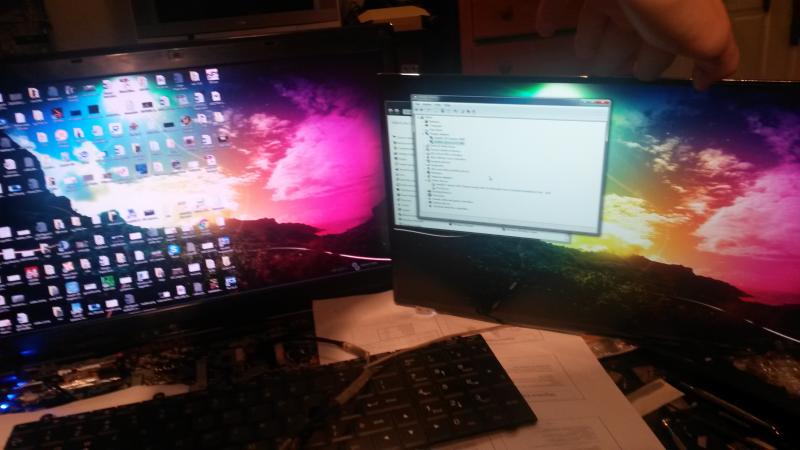-
Posts
1799 -
Joined
-
Last visited
-
Days Won
67
Content Type
Profiles
Forums
Downloads
Everything posted by Khenglish
-
Mouser is your best choice. Search for 40k SMD resistors. Case code is what determines the size of the resistor. Get one with a case code that looks correct. I'm thinking 1005 is correct (1.0mm long, 0.5 mm wide). http://www.mouser.com/Passive-Components/Resistors/_/N-5g9n?P=1yzekikZ1yzmoub
- 807 replies
-
- dell latitude e6430
- e6430
-
(and 2 more)
Tagged with:
-
If the modified vBIOS did not fix installing the driver then I am out of ideas, sorry.
-
I explained why the hardware reported ID and the vBIOS reported ID must be the same in my previous post, but this may have been lost in the translator. To repeat, other laptops will refuse to even boot if the two IDs do not match, so having them match is critical.
-
Both of those images are identical. Attached is the device ID changed to match the 560 SE. I think this will work, but be warned. Clevo systems freeze on boot if the vBIOS and hardware reported device ID do not match. I'm thinking MSI systems just have driver issues like you are seeing, but if you card is by some unseen means reporting its ID correctly on boot and now it's running this modified vBIOS, it may brick with this vBIOS. In this case you will not be able to flash back if your system behaves like a Clevo and freezes on boot. 560SE_ID.rom
-
What's interesting is that the card is running. It puts an image on the screen. It does work. Clevo systems flip out when the device ID in vBIOS does not match the device ID reported by the hardware. MSI systems probably don't like it either, which could explain your problems when installing a driver. We could modify the vBIOS to have the same 560 SE device ID that the card reports, and then your card may run perfectly fine thinking it is a 560 SE. Trying the above is just a guess though. It may completely brick the card, as it shouldn't be saying it's a 560 SE in the first place. If you want to try it though link your vBIOS here and I will change the device ID.
-

Lets enable overclocking on all 6 and 7 series laptops
Khenglish replied to Khenglish's topic in General Notebook Discussions
Unfortunately I don't know what could be going on with the BCLK slider in the latest version. The only problem I ever had was the slider completely disappearing, Intel has a description of all MSRs in the 64-ia-32-architectures-software-developer-manual which you can find on their website. I see no specific mention of MSR 0x194. -

Lets enable overclocking on all 6 and 7 series laptops
Khenglish replied to Khenglish's topic in General Notebook Discussions
The i7-3520M is definitely not turbo overclockable. I'm not sure if Lenovo systems have the proper BIOS entries for XTU to work, or to set the turbo multipliers by any means. If you can lower the multipliers on the i7-3520M in XTU, then an unlocked CPU will let you raise them. -
3x TI 87350d. This increases the current rating on the core from 120A to 240A. A 980m at 1.2V can pull up to around 240W.
-
It was plug and play on the EM with a system BIOS mod. I don't know if he tried the HM.
-
The P170EM does not require a GPU to be installed to have video because of the integrated graphics. You can run the 680m in the P170HM if you flash an older vBIOS.
-
Something that old is likely mxm v2.1, which won't even fit into the mxm slot. An older MXM 3 card will probably work, but is not guaranteed. The HM laptops had a lot of GPU compatibility quirks.
-
The P170EM should be able to run the 6970m to see if it works. The P170HM can only run the 7970m if it is the exact v1.2 version. The GPU will also need a proper vBIOS flashed on for HM systems.
-

[HARDWARE MOD] Battery cell upgrade success
Khenglish replied to Khenglish's topic in General Notebook Discussions
It sounds like you blew the fuse. Replace or bypass it. You'll also have to flash the eeprom to any backup that you may have because the controller will have set a flag that the battery is dead. -

[HARDWARE MOD] P150EM dGPU direct output WIP
Khenglish replied to Khenglish's topic in Custom Build Worklog
@Prema modified me another vBIOS for the 980 and now P0 and display on boot work with the 980 core switched over to an MSI 980m board (I damaged the clevo 980m board when switching memory chips). There seems to be something wrong with the P150EM system BIOS that is compensated for by a modified vBIOS. An added bonus is the memory now clocks higher than ever with 7.8 GHz usable in benchmarks. I got a 3K display, but am having problems getting a 40-pin eDP cable that's close enough to modify. Here's an interesting picture from September where I was running both LVDS and eDP at the same time. Unfortunately the picture quality was poor. -
By optimus bios I mean a standard bios. Prema made me some special bios that makes the dgpu the primary gpu instead of the igpu.
-
When you mouse over the card in the device manager what is the error number listed? What specifically is the error listed by the Nvidia installer? With a Prema BIOS my understanding is that an 880m driver install will work without any .inf modding to the driver. In case I am incorrect though, for driver modding it's much simpler to change one of, or all of the subsystem ID of another system to yours instead of trying to add a new gpu/system combo: %NVIDIA_DEV.1198.0270.1558% = Section028, PCI\VEN_10DE&DEV_1198&SUBSYS_02701558 to: %NVIDIA_DEV.1198.5106.1558% = Section028, PCI\VEN_10DE&DEV_1198&SUBSYS_51061558 All the linking later in the file will still work as the entry already existed.
-

Lets enable overclocking on all 6 and 7 series laptops
Khenglish replied to Khenglish's topic in General Notebook Discussions
The "before" and "after1" images are both identical. The Clock Source Select is set to send USB, PCI, SPI, LPC, and SMBUS clocks to clock source 3, but all the changes required to activate source 3 are not done, so these buses all do not have a clock. This is a 100% brick. "after2" isn't even readable by FITC. Also all these images are ME FW only. -

Lets enable overclocking on all 6 and 7 series laptops
Khenglish replied to Khenglish's topic in General Notebook Discussions
FPT will only overwrite blocks that are changed and should abort if told to overwrite regions where it does not have a matching image to replace it with. I'll check the ME FW later today. -

Lets enable overclocking on all 6 and 7 series laptops
Khenglish replied to Khenglish's topic in General Notebook Discussions
No, just the biggest. -

Lets enable overclocking on all 6 and 7 series laptops
Khenglish replied to Khenglish's topic in General Notebook Discussions
Please link a before and after firmware image so I can see what is wrong. You need to match the original image offsets onto the flash memory chips. Ex if ME FW started 3/4ths through the first chip and continues onto the 2nd on the original firmware, then you need to do that. You could reorder things by editing the flash descriptor, but there's just no reason to do that and it is just a source of more possible problems. -

Lets enable overclocking on all 6 and 7 series laptops
Khenglish replied to Khenglish's topic in General Notebook Discussions
It's on flash memory just like the BIOS. Most systems have two flash chips. The ME FW may be on one, or split across both chips. BIOS could be on the same chip or the other chip. -

Lets enable overclocking on all 6 and 7 series laptops
Khenglish replied to Khenglish's topic in General Notebook Discussions
If it won't boot after a few tries it's bricked and needs to be reprogrammed externally. -

Lets enable overclocking on all 6 and 7 series laptops
Khenglish replied to Khenglish's topic in General Notebook Discussions
"tried it"? what did you try? -

Lets enable overclocking on all 6 and 7 series laptops
Khenglish replied to Khenglish's topic in General Notebook Discussions
No, any multiplier lock will still be in effect. -

Lets enable overclocking on all 6 and 7 series laptops
Khenglish replied to Khenglish's topic in General Notebook Discussions
Yes it will. HM77 is the chipset that was actually meant for overclocking.




